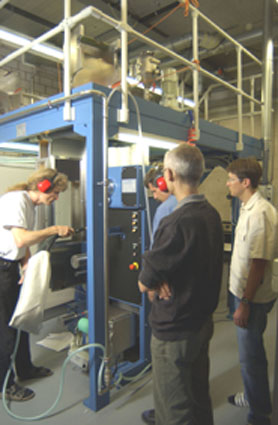|
However, less common thermoplastic base materials (for example
bioengineered plastics or “bioplastics”) can also be
used. There are a host of potential combinations that have yet to
be explored. With Spider fibres can not only be produced on a
laboratory scale, their composition and formulation can be
constantly varied with relatively little time and effort, something
which cannot be cost-effectively achieved in industrial plants. The
numerous characterization options open to Empa mean that the
properties of these new fibre types can be scientifically
predicted.
Special techniques such as plasma coating make it possible to
construct complex fibre structures and to undertake selective
chemical modifications on the fibre surface. In this way the
chemical and physical properties of the fibres can be influenced as
required, for instance their hydrophilic properties, strength,
shrinkage characteristics and elasticity. It is also possible to
incorporate nanoparticles in the cladding region to achieve a
desired functionality.
New prospects for bi-component fibres
The object of this research is to identify fibres with specific
properties for use in functional or “intelligent” textile
materials for clothing, technical and medical textiles or fibre
composites. Possible functions of these innovative textiles include
the controlled release of drugs in medical plasters, shock
absorbers in protective clothing, temperature control in
firemen’s suits or sportswear and applications in sensor
technology (for instance changing colour to indicate environmental
changes). Materials can thus be tailored to make them
biocompatible, biologically degradable, moisture-repellent or extra
absorbent, flame-retardant or odour-reducing as needs demand.
One particularly promising avenue is the application of
high-grade polymers in the form of a coating on a core made of
standard polymer with resultant savings in raw materials and
costs.
Another idea with great potential is to manufacture fibres with
photovoltaic properties. These could convert the energy of light
into electric current, turning a suit into a power plant as it
were. It’s good to know that Empa’s new spinning machine
for bi-component fibres is playing a part in this.
|



